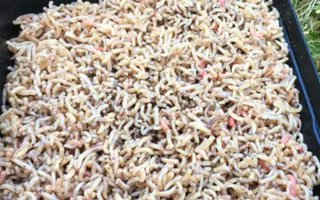Squatts are the smallest type of maggot used by anglers.
One large maggot is at least ten times heavier than a single squatt. Squatts are the must-have bait for virtually all narrow canal fishing locations when targeting the most common fish species, such as roach, skimmer, gudgeon and perch.
Building the canal peg
It's much more difficult to overfeed the fish in your peg using squatts, a very important factor on many canals and other natural venues. Canal fishing masters feed a small number of squatts on a 'little and often' basis and consequently can keep catching fish throughout a five-hour session.
Many successful canal anglers use squatts as a hook bait with either one or two on a size 22 or 24 hook, switching every now and then to a pinkie as an alternative bait to trick the fish they have targeted with the loose-fed squatts.
On stillwaters and the rivers and drains of Eastern England, squatts are primarily used as feed, either as loose feed or added to groundbait, especially when targeting large bream.
Commercial production and availability in tackle shops
Squatts are the larva of the common house fly. Like other maggots, they are bred on farms. They tend to only come in their natural white colour or dyed red. They are traditionally stored in red sand, which ideally needs to be kept slightly damp.
Regrettably, they are not always available on demand in tackle shops in some parts of the country and so need to be ordered in advance to make sure you have a good supply.
History of squatts
Squatts were being used as early as the 1890s in the north west of England and they are mentioned prominently in RE Fletcher's 'Baits and Ground Baits for Match Fishing' published in the 1920s.
Jack Mason put squatts firmly on the match fishing map, using them to triumph in the 1908 All England National held on the North Level drain at Tydd Gote.
You can find out more about the history of the use of squatts in the video below.
How to store squatts between fishing sessions
When it's warm in the summer, squatts will quickly pupate, typically in around a week or so. To slow this process down, squatts are kept in the fridge. Compared with pinkies and large maggots they don't store as well but they should be fine for four or five days.
Make sure you get the permission of the fridge owner and keep the lid of the receptacle tightly closed. (Although squatts are much less likely to escape than pinkies.)
Motty's squatt fishing tips
Advice from canal angling champion Simon 'Motty' Mottram, who trains our Let's Fish! coaches on the best canal fishing methods.
- Freshly bought squatts can be nicely fattened up by feeding them overnight on bread.
- It pays to buy fresh squatts every week as they don't keep that well for lengthy periods in the fridge.
- If you were restricted to just one canal bait, squatts would be that bait.
- With regular loose-feeding, fish become more confident and roach will move up in the water to intercept the loose-fed squatts as they fall.
- When the weather is hot, keep the bait ever so slightly damp, otherwise it will start to float.





